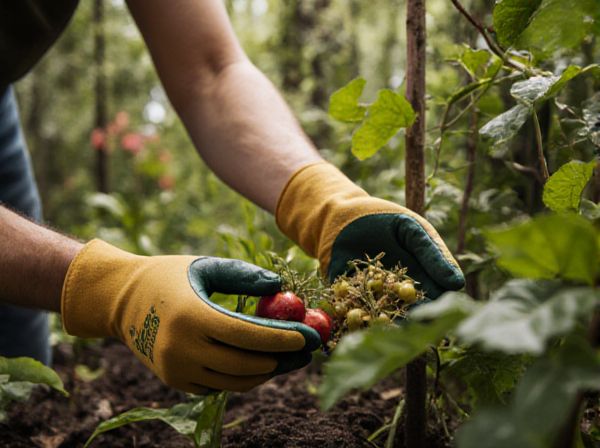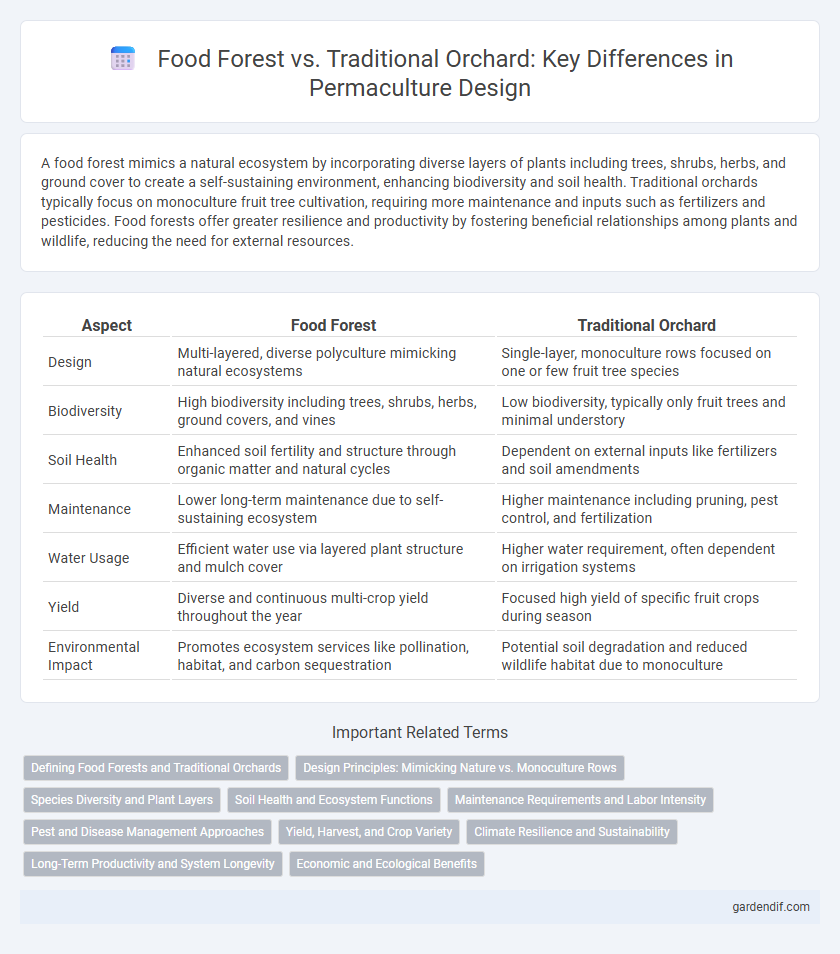
food forest vs traditional orchard Illustration
A food forest mimics a natural ecosystem by incorporating diverse layers of plants including trees, shrubs, herbs, and ground cover to create a self-sustaining environment, enhancing biodiversity and soil health. Traditional orchards typically focus on monoculture fruit tree cultivation, requiring more maintenance and inputs such as fertilizers and pesticides. Food forests offer greater resilience and productivity by fostering beneficial relationships among plants and wildlife, reducing the need for external resources.
Table of Comparison
| Aspect | Food Forest | Traditional Orchard |
|---|---|---|
| Design | Multi-layered, diverse polyculture mimicking natural ecosystems | Single-layer, monoculture rows focused on one or few fruit tree species |
| Biodiversity | High biodiversity including trees, shrubs, herbs, ground covers, and vines | Low biodiversity, typically only fruit trees and minimal understory |
| Soil Health | Enhanced soil fertility and structure through organic matter and natural cycles | Dependent on external inputs like fertilizers and soil amendments |
| Maintenance | Lower long-term maintenance due to self-sustaining ecosystem | Higher maintenance including pruning, pest control, and fertilization |
| Water Usage | Efficient water use via layered plant structure and mulch cover | Higher water requirement, often dependent on irrigation systems |
| Yield | Diverse and continuous multi-crop yield throughout the year | Focused high yield of specific fruit crops during season |
| Environmental Impact | Promotes ecosystem services like pollination, habitat, and carbon sequestration | Potential soil degradation and reduced wildlife habitat due to monoculture |
Defining Food Forests and Traditional Orchards
Food forests are multi-layered ecosystems designed to mimic natural forests, incorporating diverse plant species that provide continuous harvests and enhance soil health, biodiversity, and habitat. Traditional orchards typically consist of uniform, single-species tree rows focused primarily on fruit production, often requiring intensive management and external inputs. The design principles of food forests emphasize ecological balance and sustainability, contrasting with the simplified, productivity-driven approach of conventional orchards.
Design Principles: Mimicking Nature vs. Monoculture Rows
Food forests utilize permaculture design principles by mimicking natural ecosystems with diverse layers of plants, fostering resilience and soil health through biodiversity. Traditional orchards rely on monoculture rows that simplify management but often require synthetic inputs and increase vulnerability to pests and diseases. Emphasizing polyculture in food forests enhances ecological balance and sustainability compared to the uniformity of conventional orchard designs.
Species Diversity and Plant Layers
Food forests feature high species diversity with multiple plant layers, including canopy trees, shrubs, herbs, ground covers, and root crops, fostering ecological relationships and resilience. Traditional orchards typically consist of a single fruit tree species planted in uniform rows with minimal underplanting, resulting in lower biodiversity and fewer habitat niches. The multilayered structure of food forests enhances nutrient cycling and pest control, making them more sustainable and productive compared to conventional orchards.
Soil Health and Ecosystem Functions
Food forests enhance soil health through diverse plant layers that improve organic matter, nutrient cycling, and microbial activity, unlike traditional orchards which often rely on monoculture planting and synthetic inputs. The multilayered vegetation in food forests supports complex ecosystem functions such as habitat provision, pest regulation, and water retention, promoting greater biodiversity compared to the more simplified structure of traditional orchards. Food forests create resilient agroecosystems by mimicking natural forests, leading to improved soil structure and sustainable nutrient dynamics absent in conventional orchard systems.
Maintenance Requirements and Labor Intensity
Food forests require significantly less maintenance and labor compared to traditional orchards due to their diverse plant layers and natural ecosystem processes that enhance soil health and pest control. Traditional orchards demand regular pruning, chemical treatments, and intensive soil management to maintain monoculture productivity and prevent disease outbreaks. The polyculture design of food forests reduces the need for external inputs, creating a sustainable, low-effort system ideal for long-term fruit production.
Pest and Disease Management Approaches
Food forests utilize biodiversity and layered planting to naturally deter pests and diseases, fostering resilient ecosystems that reduce chemical interventions. Traditional orchards often rely on monoculture plantings, necessitating frequent pesticide applications and vigilant disease monitoring to manage threats effectively. Integrating beneficial insects and companion plants in food forests enhances pest control and promotes soil health compared to conventional orchard practices.
Yield, Harvest, and Crop Variety
Food forests yield diverse, multi-layered crops throughout the year, enhancing continuous harvests and increasing productivity per area compared to traditional orchards. Traditional orchards often focus on monoculture, resulting in seasonal, singular crop harvests that limit overall yield and variety. Incorporating permaculture principles, food forests optimize ecological interactions, improving soil health and resilience while supporting a broader range of edible plants and wildlife.
Climate Resilience and Sustainability
Food forests enhance climate resilience by mimicking natural ecosystems, incorporating diverse plant layers that improve soil health and water retention, reducing dependency on external inputs. Unlike traditional orchards, which typically feature monoculture tree plantings vulnerable to pests and extreme weather, food forests create sustainable habitats that support biodiversity and carbon sequestration. This integration leads to long-term sustainability through improved ecosystem services and reduced environmental impact.
Long-Term Productivity and System Longevity
Food forests enhance long-term productivity by mimicking natural ecosystems, promoting diverse, self-sustaining plant layers that improve soil health and resilience. Traditional orchards primarily rely on mono-cropping, which can deplete soil nutrients and increase vulnerability to pests over time. The multi-species structure of food forests supports sustainable yields and extended system longevity through continuous nutrient cycling and reduced need for external inputs.
Economic and Ecological Benefits
Food forests enhance economic sustainability by requiring lower maintenance costs and offering diverse, year-round harvests compared to traditional orchards. Ecologically, food forests improve soil health through multi-layered vegetation and support greater biodiversity, while traditional orchards often rely on monoculture practices that reduce habitat variety. These benefits make food forests a resilient, cost-effective option for sustainable agriculture and ecosystem restoration.
food forest vs traditional orchard Infographic

 gardendif.com
gardendif.com